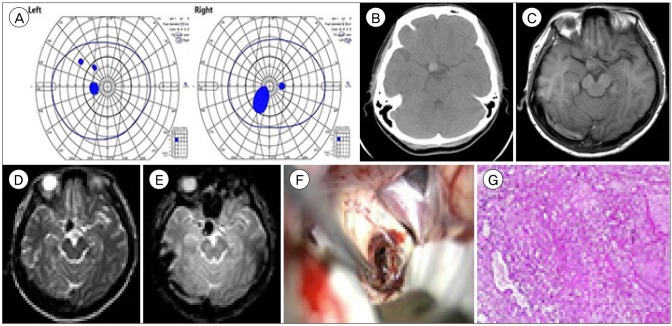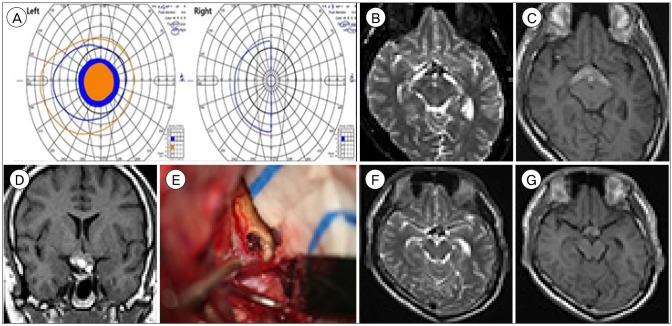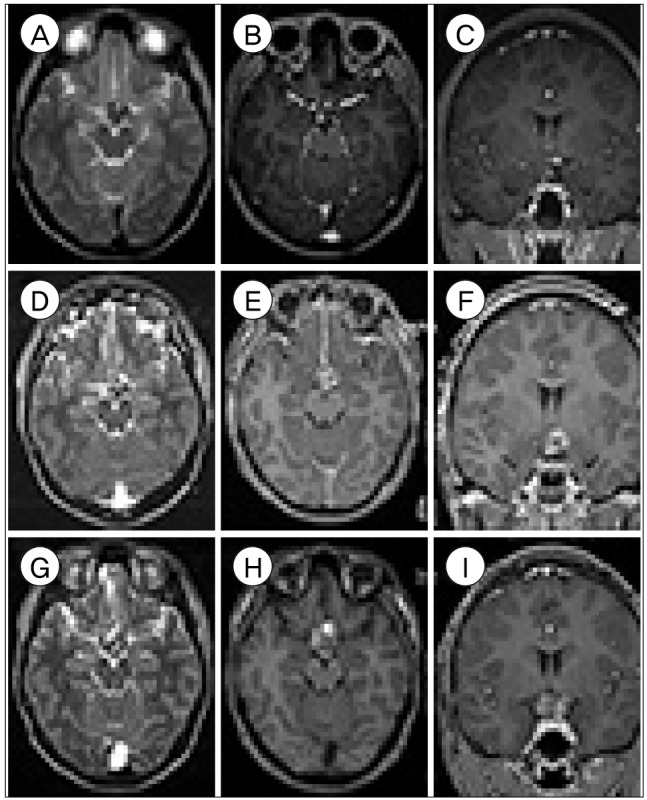J Cerebrovasc Endovasc Neurosurg.
2018 Sep;20(3):176-180. 10.7461/jcen.2018.20.3.176.
Cavernous Malformations at Optic Apparatus: Three Cases
- Affiliations
-
- 1Department of Neurosurgery, Seoul National University Hospital, Seoul, Korea. nsdrcho@gmail.com
- 2Division of Pediatric Neurosurgery, Seoul National University Children's Hospital, Seoul, Korea.
- 3Department of Anatomy, Seoul National University College of Medicine, Seoul, Korea.
- KMID: 2422769
- DOI: http://doi.org/10.7461/jcen.2018.20.3.176
Abstract
- Cavernous malformations (CMs) are angiographically occult vascular lesions, and their clinical presentations vary widely according to location of the lesion. Here, we reviewed three cases of CM located at the optic apparatus. All three patients experienced visual deterioration and underwent surgical resection. One achieved complete resection of the CM, whereas the others achieved subtotal resection. Visual symptoms of the two patients who achieved subtotal resection improved, but the visual symptom of the patient who achieved complete resection remained unchanged. One patient with subtotal resection presented postoperative improvement of visual symptoms but experienced deterioration in two years after surgical resection due to rebleeding from the remnant lesion, and he required a second operation. We recommend total resection of CM when feasible and regular follow-up after subtotal resection due to the risk of rebleeding.
Keyword
Figure
Reference
-
1. Anson JA, Spetzler RF. Surgical resection of intramedullary spinal cord cavernous malformations. J Neurosurg. 1993; 3. 78(3):446–451. PMID: 8433147.
Article2. Cho WS, Kang HS, Kim JW, Kee Park C, Kim JE. Cavernous malformation of the cisternal trigeminal nerve. Br J Neurosurg. 2011; 6. 25(3):339–340. PMID: 21355767.
Article3. Kim DG, Choe WJ, Paek SH, Chung HT, Kim IH, Han DH. Radiosurgery of intracranial cavernous malformations. Acta Neurochir (Wien). 2002; 9. 144(9):869–878. discussion 878. PMID: 12376768.
Article4. Moriarity J, Clatterbuck R, Rigamonti D. The natural history of cavernous malformations. Neurosurg Clin N Am. 1999; 7. 10(3):411–417. PMID: 10419568.
Article5. Muta D, Nishi T, Koga K, Yamashiro S, Fujioka S, Kuratsu J. Cavernous malformation of the optic chiasm: case report. Br J Neurosurg. 2006; 10. 20(5):312–315. PMID: 17129880.
Article6. Nagy G, Razak A, Rowe JG, Hodgson TJ, Coley SC, Radatz MW, et al. Stereotactic radiosurgery for deep-seated cavernous malformations: a move toward more active, early intervention: clinical article. J Neurosurg. 2010; 10. 113(4):691–699. PMID: 20433275.7. Del Curling O Jr, Kelly DL Jr, Elster AD, Craven TE. An analysis of the natural history of cavernous angiomas. J Neurosurg. 1991; 11. 75(5):702–708. PMID: 1919691.
Article8. Robinson JR, Awad IA, Little JR. Natural history of the cavernous angioma. J Neurosurg. 1991; 11. 75(5):709–714. PMID: 1919692.
Article9. Rotondo M, Natale M, D'vanzo R, Pascale M, Scuotto A. Cavernous malformations isolated from cranial nerves: unexpected diagnosis? Clin Neurol Neurosurg. 2014; 11. 126:162–168. PMID: 25255160.
Article10. Simard JM, Garcia-Bengochea F, Ballinger WE Jr, Mickle JP, Quisling RG. Cavernous angioma: a review of 126 collected and 12 new clinical cases. Neurosurg. 1986; 2. 18(2):162–172.
Article
- Full Text Links
- Actions
-
Cited
- CITED
-
- Close
- Share
- Similar articles
-
- Cavernous Malformation of the Optic Chiasm : Case Report
- Incidence of Enhancement of the Optic Nerve/Sheath Complex in Fat-Suppression Orbit MRI
- Surgical Treatment of Cavernous Malformation of Pineal Region
- Cavernous Hemangioma of the Cauda Equina
- Epidemiology and Natural History of Cavernous Malformations




